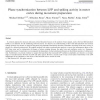34 search results - page 5 / 7 » Self-organization of spiking neurons using action potential ... |
ICASSP
2011
IEEE
12 years 11 months ago
2011
IEEE
We present a novel, maximum likelihood framework for automatic spike-sorting based on a joint statistical model of action potential waveform shape and inter-spike interval duratio...
NECO
2007
13 years 7 months ago
2007
Learning agents, whether natural or artificial, must update their internal parameters in order to improve their behavior over time. In reinforcement learning, this plasticity is ...
IJON
2007
13 years 7 months ago
2007
A common approach to measure and assess cortical dynamics focuses on the analysis of mass signals, such as the local field potential (LFP), as an indicator for the underlying net...
NIPS
2004
13 years 8 months ago
2004
The representation of acoustic signals at the cochlear nerve must serve a wide range of auditory tasks that require exquisite sensitivity in both time and frequency. Lewicki (2002...
BC
2004
13 years 7 months ago
2004
Abstract. The neural circuits of birdsong appear to utilize specific time delays in their operation. In particular, the anterior forebrain pathway (AFP) is implicated in an approxi...

